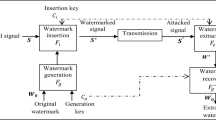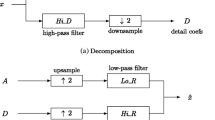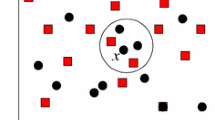Abstract
Based the characteristics of the human auditory system (HAS) and the techniques of neural networks, this work proposes an Adaptive Signal-Dependent Audio Watermarking (ASDAW) technique for protecting audio copyrights. First, a signal-dependent watermark for the ASDAW technique is generated by using the characteristics of the HAS (the temporal and frequency maskings). Next, the signal-dependent watermark is hidden in an original audio on the temporal domain. The ASDAW technique can make the signal-dependent audio watermark imperceptive (inaudible) because of the characteristics of the HAS. Moreover, an artificial neural network (ANN) is trained in the ASDAW technique so that the ASDAW technique can memorize the relationships between an original audio and the corresponding watermarked audio. Using the trained ANN (TANN), the ASDAW technique can extract the signal-dependent watermarks without the original audio. The extracted watermarks are then exploited in verifying legal duplications made of an audio during audio authentication. Consequently, the copyright forgery for audio can be suppressed greatly. Furthermore, experimental results illustrate that the ASDAW technique significantly possesses memorized, adaptive, and robust capabilities, making it immune against common audio manipulations and pirate attacks for counterfeiting audio copyrights.
Similar content being viewed by others
References
P. Noll, “Wideband speech and audio coding,” IEEE Comm. Magazine, vol. 31, pp. 34–44, 1993.
ISO/IEC IS 11172 (MPEG). Information technology—coding of moving pictures and associated audio for digital storage up to about 1.5 Mbits/s, 1993.
D. Pan, “A tutorial on mpeg audio compression,” IEEE Multimedia Journal, vol. 2, pp. 60–74, Summer 1995.
P. Noll, “MPEG digital audio coding,” IEEE Signal Processing Magazine, vol. 145, pp. 59–81, 1997.
I. Pitas and T. Kaskalis, “Applying signatures on digital images,” Nonlinear Signal Processing Workshop, Thessaloniki, Greece, pp. 460–463, 1995.
W. Bender, D. Gruhl, N. Morimoto, and A. Lu, “Techniques for data hiding,” IBM Systems Journal, vol. 35, no. 34, pp. 313–337, 1996.
W. Zeng and B. Liu, “On resolving rightful ownerships of digital images by invisible watermarks,” in Proc. IEEE Int. Conf. Image Processing, vol. 1, 1997, pp. 552–555.
I.J. Cox, J. Kilian, F.T. Leighton, and T. Shamoon, “Secure spread spectrum watermarking for multimedia,” IEEE Trans. on Image Processing, vol. 6, no. 12, pp. 1673–1687, 1997.
X.-G. Xia, C. G. Boncelet, and G. R. Arce, “A multiresolution watermark for digital images,” in IEEE ICIP,vol. 1, July 1997, pp. 548–551.
I. Hong, I. Kim, and S.-S. Han, “A blend watermarking technique using wavelet transform,” in IEEE ISIE,Pusan, Korea, 2001, pp. 1946–1950.
M.D. Swanson, M. Kobayashi, and A.H. Tewfik, “Multimedia data-embedding and watermarking technologies,” in Proc. of IEEE, vol. 86, no. 6, June 1998, pp. 1064–1087.
M. Kutter, F. Jordan, and F. Bossen, “Digital watermarking of color images using amplitude modulation,” Journal of Electronic Imaging, vol. 7, no. 2, pp. 326–332, 1998.
F. Hartung and M. Kutter, “Multimedia watermarking techniques,” in Proc. of IEEE, vol. 87, no. 7, July 1999, pp. 1079–1107.
G. Voyatizis and I. Pitas99, “The use of watermarks in the protection of digital multimedia products,” in Proc. of IEEE, vol. 87, no. 7, 1999, pp. 1197–1207.
P.-T. Yu, H.-H. Tsai, and J.-S. Lin, “Digital watermarking based on neural networks for color images,” Signal Processing, vol. 81, Mar. 2001, pp. 663–671.
L. Boney, A. H. Tewfik, and K. N. Hamdy, “Digital watermarks for audio signals,” in IEEE Proceedings of Multimedia, 1996, pp. 473–480.
P. Prandoni and M. Vetterli, “Perceptually hidden data transmission over audio signals,” Proc. IEEE Int. Conf. on Acoustics, Speech and Signal Processing, vol. 6, 1998, pp. 3665–3668.
M.D. Swanson, B. Zhu, A. H. Tewfik, and L. Boney, “Robust audio watermarking using perceptual masking,” Signal Processing, vol. 66, pp. 337–355, 1998.
I.K. Yeo and H.J. Kim, “Modify patchwork algorithm: A novel watermarking scheme,” in Proc. Int. Conf. on Information Technology: Coding and Computing, Apr. 2001, pp. 237–242.
J.W. Seok and J.W. Hung, “Audio watermarking for copyright protection of digital audio data,” Electronics Letters, vol. 37, no. 1, 2001, pp. 60–61.
P. Bassia, I. Pitas, and N. Nikolaidis, “Robust audio watermarking in the time domain,” IEEE Trans. on Multimedia, vol. 3, no. 2, pp. 232–241, 2001.
A. Shamir, “On the generation of cryptographically strong pseudo-random sequences,” Lecture Notes in Computer Science 62: 8thInternational Colloquium on Automata, Languages, and Programming, Spring-Verlag: Berlin, 1981.
L. Blum, M. Blum, and M. Shub, “A simple unpredictable pseudo-random number generator,” SIAM Journal on Computing, vol. 15, no. 2, pp. 364–383, 1986.
H.-H. Tsai and P.-T. Yu, “Adaptive fuzzy hybrid multichannel filters for removal of impulsive noise from color images,” Signal Processing, vol. 7, no. 2, pp. 127–151, 1999.
H.-H. Tsai and P.-T. Yu, “On the optimal design of fuzzy neural networks with robust learning for function approximation,” in IEEE Trans. on Systems, Man, and Cybernetics: Part B, vol. 30, no. 1, pp. 217–223, 2000.
S. Haykin, Neural Networks: A Comprehensive Foundation, Macmillan College Publishing Company: New York, 1995.
Author information
Authors and Affiliations
Corresponding author
Additional information
This work was in part supported by the National Science Council, R.O.C., under Grant NSC 90-2213-E-150-008.
Rights and permissions
About this article
Cite this article
Tsai, HH., Cheng, JS. Adaptive Signal-Dependent Audio Watermarking Based on Human Auditory System and Neural Networks. Appl Intell 23, 191–206 (2005). https://doi.org/10.1007/s10489-005-4607-y
Issue Date:
DOI: https://doi.org/10.1007/s10489-005-4607-y




